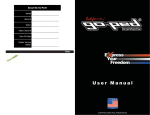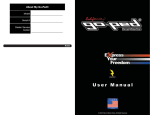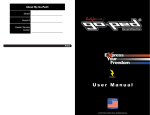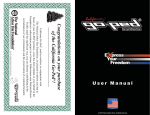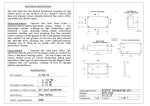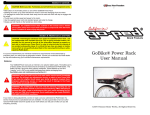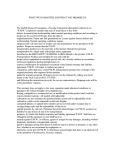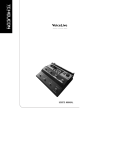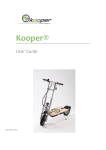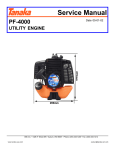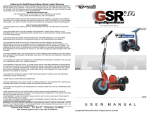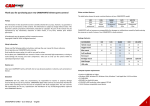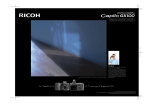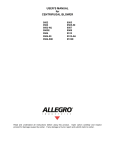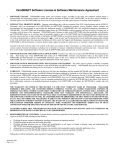Download About My Go-Ped® Model
Transcript
About My Go-Ped® Model _______________________ Serial # _______________________ Motor _______________________ Motor Serial # _______________________ Gas:Oil Ratio _______________________ Dealer Service Center _______________________ Notes WHAT WE GUARANTEE AND WHAT YOU PROMISE US Patmont Motor Werks, a Nevada Corporation (hereinafter referred to as “P.M.W.”) expressly warrants that each of its products is free from defects in material and workmanship under normal operating conditions and according to proper use for a period of 90 days from the date of original purchase. Frame and fork guaranteed for 2 years against factory defects and workmanship. Normal operating conditions require adequate fuel / oil ratio and / or routine care and maintenance by the purchaser of the product. Proper use means that the P.M.W. transportation product is to be used only in the manner intended for personal transportation of a single rider with proper safety equipment described on the RED SAFETY WARNING LABEL affixed to the product. P.M.W. Transportation Products are intended for use only with the proper safety equipment on smoothly paved, safe, dry, non-oily surfaces in accordance with local regulations during daylight hours. In express consideration for purchasers execution of the limited warranty and liability agreement, P.M.W. will repair or replace any part or component, other than tires, of the P.M.W. transportation product free of charge to the original purchaser who registers his/her product under the warranty program. Warranty service can be obtained by calling your local dealer or the Tech. Line at (925) 373-7827 and following the instructions given by the service representative. Shipping costs will be at the purchasers’ expense. This warranty does not apply to tire wear, operation under abnormal conditions or damage to the vehicle brought on by improper use. Racing, competitive or commercial use, or modification of the product shall void this express limited warranty. All models with the G260RC engine and the GSR40i are not warranted for piston/cylinder seizure due to adjustability of the carburetor, which can be tampered by end user. Engine crankshaft failures on spindle drive models are not covered under warranty due to varying riding styles and the adjustability of the tire to spindle pressure by end user. Purchaser herewith acknowledges: (a) P.M.W. assumes no liability for any misuse of any of its transportation products. (b) Under this limited warranty and liability agreement P.M.W. shall have no obligation and the purchaser or user shall have no remedy against P.M.W., its officers, agents or assigns for any damages, including without limitation, incidental, consequential, special, punitive damages arising from direct or indirect injury to person or property, or any other loss, whether or not occasioned by negligence, or otherwise, on the part of P.M.W. (c) Purchaser acknowledges that there is an inherent risk in the operation of motorcycles, bicycles, mopeds, and all P.M.W. transportation products, and herewith assumes the risk of any injury arising from operation of any P.M.W. transportation product. Original owner will indemnify and hold P.M.W. harmless and will take full responsibility for conveying all safety warnings, instructions, and limited warranty if unit is sold, lent, or otherwise transferred to other persons and will indemnify P.M.W. from any claims against it for original owners’ failure to do so. THE EXPRESS LIMITED WARRANTY DESCRIBED ABOVE SHALL BE EXCLUSIVE AND THERE IS NO OTHER WARRANTY OR LIABILITY, EXPRESS OR IMPLIED, ARISING BY LAW OR OTHERWISE AND WHETHER OR NOT OCCASIONED BY SELLER’S NEGLIGENCE. THERE IS NO IMPLIED WARRANTY OF MERCHANTABILITY OR FITNESS FOR A PARTICULAR PURPOSE. THERE ARE NO WARRANTIES WHICH EXTEND BEYOND THOSE EXPRESSLY STATED HEREIN. NOTICE: Some states do not allow the exclusion or limitation of incidental or consequential damages and some states do not allow limitation on how long an implied warranty lasts, therefore, some of the above limitations may not apply to you. NOTICE: Your Homeowners Insurance may not cover either Direct or Third Party Liability Claims arising from use of this or any other GoPed® product. PLEASE ACKNOWLEDGE THAT YOU HAVE READ AND UNDERSTAND EACH WARNING BY PLACING YOUR INITIALS IN EACH BOX ______ This device does not conform to Federal Motor Vehicle Safety standards and is not intended for operation on public streets, roads or highways. ______ Safety helmet, goggles, gloves, elbow, and knee pads, appropriate shoes, and bright clothing must be worn while operating this device to reduce potential of injury. ______ Do not operate this device in traffic, or on wet, frozen, oily or unpaved surfaces. Avoid uneven surfaces, chuckholes, surface cracks, obstacles and night or conditions of darkness. ______ Never carry passengers and objects that can hinder your abilities to safely operate your vehicle. ______ Pregnant persons should not use this product. ______ Never use alcohol or drugs before or while operating this device. They slow reaction time and impair judgment. ______ This product should not be used by minors without adult supervision. ______ High speeds, jumps and trick maneuvers are dangerous and could result in loss of control and other accidents. ______ When accelerating or climbing hills, you will need to lean forward, under braking conditions you will need to lean back, to keep wheels in contact with the ground. ______ Never permit a guest to use this device unless the guest has read the user manual and all labels. ______ I agree to provide my guest with helmet, safety goggles, elbow pads, and knee pads. ______ Engine shut off switch is available for rear wheel braking or for use in the event of throttle failure or other emergency when engine shut off is desired. ______ This product should not be used by persons unwilling or unable to take responsibility for their own actions. ______ Read all additional warnings and instructions in user manual before operating this P.M.W. product. ______ Adults purchasing this Unit for Children, inclusive but not limited to a Parent or Guardian, assume direct liability for injury to the child, or to third parties to whom the child entrusts the vehicle. ______ Homeowners Insurance may not cover either Direct or Third Party Liability Claims Arising from Use of this or any other Go-Ped® product. ______ I herewith promise not to entrust this vehicle to any child under 16 (Sixteen) years of age. ______ Never remove exhaust tube from manifold of engine or serious damage to your Go-Ped and yourself will result. WE SETTLE ARGUMENTS BY ARBITRATION ANY DISPUTE HEREUNDER WILL BE RESOLVED THROUGH BINDING ARBITRATION IN THE CITY OF RENO, COUNTY OF WASHOE, NEVADA, ACCORDING TO THE RULES GERMANE TO ARBITRATIONS CONTAINED IN REVISED NEVADA STATUTES. California Go-Ped®/Patmont Motor Werks Limited Warranty EMISSION RELATED PARTS, FOR TWO (2) YEARS FROM THE DATE OF ORIGINAL DELIVERY, PATMONT MOTOR WERKS (THE COMPANY), THROUGH ANY GO-PED® DEALER, WILL REPAIR OR REPLACE, FREE OF CHARGE, FOR THE ORIGINAL AND EACH SUBSEQUENT PURCHASER, ANY PART OR PARTS FOUND TO BE DEFECTIVE IN MATERIAL AND/OR WORKMANSHIP, EMISSION-RELATED PARTS ARE: THE CARBURETOR ASSY, COIL ASSY, ROTOR, SPARKPLUG, AIR FILTER, FUEL FILTER, INTAKE MANIFOLD, AND THE GASKETS ALL OTHER PARTS EXCEPT ABOVE PARTS, FROM THE DATE OF ORIGINAL DELIVERY, THE COMPANY, THROUGH ANY GO-PED® DEALER WILL REPAIR OR REPLACE, FREE OF CHARGE, FOR THE ORIGINAL PURCHASER. ANY PART OF PARTS FOUND TO BE DEFECTIVE IN MATERIAL AND/OR WORKMANSHIP. THIS IS THE EXCLUSIVE REMEDY: -THE PURCHASER SHALL BEAR COSTS OF TRANSPORTING THE UNIT TO AND FROM THE GO-PED® DEALER. -THE PURCHASER SHALL NOT BE CHARGED FOR DIAGNOSTIC LABOR WHICH LEADS TO THE DETERMINATION THAT A WARRANTED PART IS DEFECTIVE, IF THE DIAGNOSTIC WORK IS PERFORMED AT THE GO-PED® DEALER. -THE PURCHASER OR OWNER IS RESPONSIBLE FOR THE PERFORMANCE OF THE REQUIRED MAINTENANCE AS DEFINED BY THE MANUFACTURER IN THE OWNER/OPERATOR MANUAL. -ANY WARRANTED PART WHICH IS NOT SCHEDULED FOR REPLACEMENT AS REQUIRED MAINTENANCE, OR WHICH IS SCHEDULED ONLY FOR REGULAR INSPECTION TO THE EFFECT OF “REPAIR OR REPLACE AS NECESSARY” SHALL BE WARRANTED FOR THE WARRANTY PERIOD. ANY WARRANTED PART WHICH IS SCHEDULED FOR REPLACEMENT AS REQUIRED MAINTENANCE SHALL BE WARRANTED FOR THE PERIOD OF TIME UP TO THE FIRST SCHEDULED REPLACEMENT POINT FOR THE PART. -ANY REPLACEMENT PART THAT IS EQUIVALENT IN PERFORMANCE AND DURABILITY MAY BE USED IN NON-WARRANTY MAINTENANCE OR REPAIRS, AND SHALL NOT REDUCE THE WARRANTY OBLIGATION OF THE COMPANY. -THE COMPANY IS LIABLE FOR DAMAGES TO OTHER ENGINE COMPONENTS CAUSED BY THE FAILURE OF A WARRANTED PART STILL UNDER WARRANTY. -THE WARRANTY DOES NOT APPLY TO THOSE UNITS WHICH HAVE BEEN DAMAGED BY NEGLIGENCE OF INSTRUCTION LISTED IN THE OWNER/OPERATOR MANUAL FOR PROPER USE AND MAINTENANCE OF THE UNIT, ACCIDENT, MISHANDLING, ALTERATION, ABUSE, IMPROPER LUBRICATION, USE OF ANY PARTS OR ACCESSORIES OTHER THAN THOSE SPECIFIED BY THE COMPANY, OR OTHER CAUSES BEYOND THE COMPANY’S CONTROL. -THIS WARRANTY DOES NOT COVER THOSE PARTS REPLACED BY NORMAL WEAR OR HARMLESS CHANGES IN THEIR APPEARANCE. -THERE ARE NO OTHER EXPRESS WARRANTIES. -IMPLIED WARRANTIES INCLUDING THOSE OF MERCHANTABILITY AND FITNESS FOR A PARTICULAR PURPOSE ARE LIMITED TO 90 DAYS FROM THE ORIGINAL DELIVERY DATE. -LIABILITIES FOR INCIDENTAL OR CONSEQUENTIAL DAMAGE UNDER ANY AND ALL WARRANTIES ARE EXCLUDED. -SOME STATES DO NOT ALLOW LIMITATIONS ON HOW LONG AN IMPLIED WARRANTY LASTS OR EXCLUSION OR LIMITATION OF _________ (Purchaser’s Initials Required) INCIDENTAL OR CONSEQUENTIAL DAMAGES, SO THE ABOVE LIMITATION OR EXCLUSION MAY NOT APPLY TO YOU. NOTICE: BY SIGNING BELOW YOU ARE AGREEING TO HAVE ANY DISPUTES ARISING OUT OF THE MATTERS INCLUDED IN THE ‘ARBITRATION OF DISPUTES’ PROVISION DECIDED BY NEUTRAL ARBITRATION AS PROVIDED BY NEVADA LAW, AND THAT YOU ARE GIVING UP ANY RIGHTS YOU MIGHT POSSESS TO HAVE THE DISPUTE LITIGATED IN A COURT OR JURY TRIAL. BY SIGNING BELOW YOU ARE GIVING UP YOUR JUDICIAL RIGHTS TO DISCOVERY AND APPEAL, UNLESS THOSE RIGHTS ARE SPECIFICALLY INCLUDED IN THE ‘ARBITRATION OF DISPUTES’ PROVISION. IF YOU REFUSE TO SUBMIT TO ARBITRATION AFTER AGREEING TO THIS PROVISION, YOU MAY BE COMPELLED TO ARBITRATE UNDER THE AUTHORITY OF THE NEVADA CODE OF CIVIL PROCEDURE. YOUR AGREEMENT TO THIS ARBITRATION PROVISION IS VOLUNTARY. -THIS WARRANTY GIVES YOU SPECIFIC LEGAL RIGHTS, AND YOU MAY ALSO HAVE OTHER RIGHTS WHICH VARY FROM STATE TO You should feel free to consult an attorney before signing this limited warranty and liability agreement. I have read understood and agreed to be bound by the limited warranty and liability agreement above and agree to submit disputes arising out of matters included in the arbitration of disputes provision to neutral arbitration. STATE. -IF YOU NEED TO OBTAIN INFORMATION ABOUT THE NEAREST SERVICE CENTER, PLEASE CALL PATMONT MOTOR WERKS AT (925) 373-7827 or visit www.goped.com IMPORTANT: YOU WILL RECEIVE A WARRANTY REGISTRATION FORM AT TIME OF PURCHASE. PLEASE FILL OUT THE FORM AND SEND IT TO GO-PED®/PATMONT MOTOR WERKS WITHIN SEVEN (7) DAYS. BE SURE TO KEEP A COPY FOR YOUR RECORDS. Patmont Motor Werks P.O. Box 97 Pleasanton, CA 94566 9.5 Suspension: Contents For products with suspension there are a few adjustment proceedures you need to be aware of: Section 1: Important Information • 1.1) About this Manual 1.2) A SPECIAL NOTE FOR PARENTS Although your suspension is adjustable it comes pre-adjusted and ready to ride from the factory. • To make adjustments to your suspension, screw the adjustment screws (fig 1) in (tighten) for stiffer suspension feel, or out (loosen) for a more plush feel. • It may take a bit of riding for the suspension to adapt completely to the adjustments made. Adjustments should be made in small increments and a light thread lock fluid may be needed to ensure screw setting. • The nut in the middle of the suspension “knuckle” is for the disassembly of the suspension only. It takes special tools to assemble the suspension properly so consult an authorized Go-Ped® Dealer before attempting any replacement of internal suspension parts. Section 2: Safety 2.1) Equipment Safety 2.2) Mechanical Safety Check 2.3) Scooting Safety 2.4) Rules to Scoot By 2.5) Stunts, Wheelies, or Jumps 2.6) Wet Weather Riding Section 3: Assembly 3.1) Pre-assembled scooters 3.2) Some assembly required 3.3) Folding Feature Section 6: Starting 6.1) Starting your non chain drive model 6.2) Starting your specialized models without pull starters 6.3) Starting your chain drive models 6.4) Starting your Bigfoot™, Go-Quad®, Super Go-Quad™ 6.5) Engine Starting Instructions 6.6) Motorized Riding Section 7: Free Wheel Scooting 7.1) Non-Chain Driven Models 7.2) Bigfoot™ 7.3) Chain Drive Models Section 8: Maintenance and Parts 8.1) Service and Maintenance Schedule 8.2) Special Engine Maintenance Section 4: Oil & Fuel Information Section 9: Adjustment 4.1) Oil and Fuel Mixing Instructions 4.2) Fueling & Pre-Operation Section 5: Controls 9.1) Brakes 9.2) Control Levers and Cables 9.3) Wheels 9.4) Chain tension adjustments 9.5) Suspension Adjustment Thank you for your recent acquisition of a California Go-Ped® brand product! We are very happy and proud to welcome you to California Go-Ped®, the World’s Best in Extreme Fun, Innovation and Quality. By choosing California Go-Ped®, you have selected the highest quality scooter products in the World, which have been handcrafted in the USA since 1985, using aircraft grade materials and the highest quality components. As the leader in innovation, design and performance California Go-Ped® has paved the way for personal transportation by producing lightweight, fuel efficient, durable, performance minded, and wellbalanced machines. As a new Go-Ped® owner and User, you now have access to the widest dealer network, thousands of parts for your Go-Ped®, complete warranty coverage and instant access to service. You are now part of the fastest growing community of scooter enthusiasts in the world. A technical hot line is available if you may need further assistance that this manual does not provide at 925-373-7827 Attention: For more information on the California Go-Ped® Company and Go-Ped® brand products, please visit us on-line at www.goped.com. You will also be able to find your local GoPed® dealer, buy OEM parts, learn about the latest news and Go-Ped® related events, receive product support information, and get connected with other Go-Pedders. Section 1: Important Information 1.1 About this Manual Why you should read this manual: This manual was written to help you understand the operation and maintenance of your vehicle. It’s important for you to understand your new scooter, its features and operations so that your first ride will get you the most from your new scooter/kart and keep it maintained for optimum performance and safety. It is also important that your first ride on a new scooter is taken in a controlled environment, away from vehicles, obstacles and other hazards. Even if you have previous experience with motorized scooters, vehicles, bikes, and the likes, you probably need an update of your scooting habits, knowledge and assumptions. There are many changes in technologies and construction which can affect function, handling, performance and safety of your scooter/kart. General Warning: Scooting/karting can be a hazardous activity even under the best of circumstances. Proper maintenance of your scooter/kart is your responsibility as it helps reduce the risk of injury. This manual contains many “Warnings” and “Cautions” concerning the possible consequences of failure to follow instructions, perform maintenance, or inspect your scooter. Any fall can result in serious injury or even death, so operating within the guidelines outlined in this manual will help reduce those risks. Attention: • The status of the Go-Ped® as a “motor vehicle” varies from state to state and is subject to drivers licensing, insurance requirements and registration. • You should check with a reliable authority in your state to see if the Go-Ped® must be registered as a motor vehicle. Your police department or local department of motor vehicles may be able to answer your questions or direct you to a reliable authority. • Your insurance policies may not provide coverage for accidents involving the use of this vehicle. To determine if coverage is provided you should contact your insurance company or agent. • The recommended age and minimum weight for the Go-Ped® is 16 years of age or older and 100 pounds, but this is subject to the physical coordination of the rider, the ability of the rider to wear protective gear, use good decision making ablity, and to take responsibility for their own actions. 1.2 A SPECIAL NOTE FOR PARENTS It’s a tragic fact that most children are more likely to have an accident. As a parent or guardian, you bear the responsibility for the activities and safety of your minor child. Among these responsibilities are to make sure that the scooter/kart which your child is riding is properly fitted to the child; that it is in good repair and in safe operating condition; that you and your child have learned, understand and obey not only the applicable local motor vehicle and traffic laws, but also the common sense rules of safe and responsible scooting. As a parent you should read this manual and go over all key points with your child before letting your child ride the scooter/kart. Section 2: Safety 2.1 Equipment Safety Warning: Many States or regions require specific safety devices or equipment. It is your responsibility to familiarize yourself with laws of the state or region in which you ride and to comply with all applicable laws, including properly equipping yourself and your scooter/kart. 5) Lock down quick release lever with snug pressure. This will lock axle in position until readjustment is required again. You are now finished adjusting the rear wheel. CAUTION: Rear wheel adjustment will be required more frequently when tire is new and when scooter is driven aggressively. Adjust frequently to prevent drive system slippage and prematurely wearing out the tire. If drive system is allowed to slip excessively, high temperatures/friction will result in damage to the drive spindle and premature tire wear, extreme and uneven tire wear can result, causing uneven overloading to engine crankshaft and bearing. Refer to “Adjusting the rear wheel” section in this manual to correct drive system engagement issues. Contents Proper chain care and maintenance is essential to longevity and wear of the drive components on your chain drive scooter. • Make sure that the sprockets are perfectly aligned to each other. Use a long straight edge or you can check this visually by lining up the rear sprocket with the front and seeing that the chain is straight. • For scooters equipped with a pivoting motor mount chain tension adjustment: The motor mount on units with a pivoting motor mount allows chain tension adjustment to accommodate chain stretch and/or sprocket wear. To adjust the motor mount simply loosen the two 3/8 nylock nuts located on the right side of the scooter and pivot the motor mount forward until the 3/4" specified chain tension is achieved. Once the desired tension is achieved, retighten the 3/8 nuts. Failure to keep the chain properly adjusted will result in premature sprocket and chain wear. The sprockets may be aligned by adding or removing washers between the rear wheel and the frame. •More about chain tension: Some motor mounts are equipped with a single carriage bolt which helps to hold the motor in place. Adjust the bolt until the head of the bolt touches the frame, then lock the bolt in place with the locknut. CAUTION: Tightening the chain more than necessary will cause your drive components to wear prematurely and add performance reducing drive system friction. • The chain should be lubricated before each ride. • Your chain should be clean. A safe cleaning solvent can be used but the chain must be oiled once it is dry. • To reduce dirt and grime buildup and overspray on rear brake components, never over lubricate the chain. • Sprockets should be periodically checked for damage and wear. If you notice that there is any damage to the sprockets or a tooth missing it should be replaced immediately. CAUTION: Never lubricate chain while motor is running. For fabric type air filters (46cc engine) lightly oil entire air filter element with air filter oil. Do Not Over Oil. Only Use Air Filter Oil Brake lever and cable: Make sure the cable is not frayed or kinked in any way and also check to be sure that the cable housing ends are securely seated. An adjustment is available at the brakes and you can increase or take up slack by screwing or unscrewing the adjustment barrel. Twist lever and cable: On the Bigfoot™ your twist lever engages or disengages the motor’s drive component. With the lever in the full up position the drive spindle must not touch the wheel in anyway. When the lever is in the full down position you should have ample slack in the cable to allow for spindle to be fully engaged with the tire. There are adjustment barrels on each end of the cable housing for the twist lever. 9.3 Wheels Front wheel removal: 1) Make a note of the location for the washers used on the front axle. 2) Remove the axle nut. 3) Slide the axle bolt out and remove wheel. Rear Wheel Removal: 1) Make a note of the location for the washers used on the front axle. 2) Remove the axle nut. 3) Slide the axle bolt out and remove wheel. Note: On some units the fender can pivot clear of the wheel for easy access once the axle nut is removed. CAUTION: Only use original equipment for your Go-Ped®. Substituting with other brands may have unforeseen dangers that could cause damage, making your Go-Ped® perform in an unsafe manner, causing damage and/or personal injury. Replacing the solid rubber tire : 1) Use hacksaw and carefully cut off the old tire from rim. 2) Take new tire and dip in body of water. 3) Work one side of tire all the way around the rim. 4) Place wheel on ground over a soft surface such as an old piece of carpet/cardboard. 5) Very carefully, but firmly, compress the assembly together. Warning: Do no use any grease, oil, or solvents to help install rubber tire. A. Helmets: While not all States or regions require riders to wear approved protective head gear, common sense dictates that you should wear a DOT, Snell, BSI or CPSC approved helmet. Most serious incidences involve head injuries which might have been avoided if the rider had worn a helmet. Your authorized Go-Ped® dealer may have a variety of attractive approved helmets, and can recommend one to suit your needs. Make sure that it fits correctly, is worn correctly and is properly secured. Ask your dealer to help with the fit and adjustment of your helmet, or refer to the owner’s manual provided with the helmet. Buckle Up! WARNING: Always wear an approved helmet when riding your scooter. Helmet should be worn correctly as outlined in the owner’s manual for the helmet. Failure to wear an approved helmet can result in serious injury or death. B. Protective pads: Elbow pads, knee pads, and wrist guards are not required by most states or regions. Again, common sense dictates that you should wear protective pads to help protect against injury. Your authorized Go-Ped® dealer may have a variety of protective pads, and can recommend one to suit your needs. A good set of pads should fit comfortably, stay in position at all times and not have any excess strapping, Velcro®, or other protrusions to catch on anything that can cause you to lose control of your scooter/kart. C. Shoes: Your shoes should have good grip, protection, and support. Your shoes should have adequate strapping or laces so they stay on your feet. Make sure that laces or other strapping can not catch or hang-up on any part of the scooter or other objects. Never ride barefoot or wear sandals when operating the scooter. Note: Only use original Go-Ped® tires. Replacing the rubber tire takes some practice. If you are having trouble, have your authorized Go-Ped® dealer teach you, or have them perform this task for you. D. Clothing: Being seen is very important. Brightly colored, reflective helmets and clothing will help make riders more noticeable. Clothing should not be so loose that it can catch on moving parts or be snagged on other objects. Replacing pneumatic tires and tubes: The tires and tubes are critical components requiring precise reassembly to insure proper alignments. An authorized Go-Ped® dealer using OEM parts should do this operation. E. Eye protection: Any kind of riding can involve airborne debris, dust, and bugs, so common sense dictates that you should wear protective eyewear with protective lenses. Warning: Completely deflate wheel before wheel disassembly. Failing to do so can result in serious injury. Adjusting the rear wheel: For non-chain driven models only. To get maximum life out of your tires and scooter you should follow these directions and adjust frequently. 1) Open quick release axle to unlock and allow free movement of wheel (wingnut may need to be loosened also). 2) With Quick Release Axle opened and loosened, rotate engine protection washer (EPW) down, away from rear gas tank support stud. 3) Apply approx. 75 lb of weight to rear part of Go-Ped® deck (one knee on the “D” works pretty good) with rear wheel on the ground. (To apply proper tire/spindle contact). 4) Rotate engine protection washer (EPW) up to contact rear gas tank stud while weight is still applied, this will prevent overload to engine bearings and crankshaft. F. Reflectors: Reflectors are important safety devices designed to reflect light in a way that helps to be seen. The reflectors are intended to enhance the visibility of the scooter but may not meet reflector requirements for your area. WARNING: Do not remove the reflectors from your scooter. Removing reflectors may reduce visibility to others. Reflectors are not suitable for use as lights. Riding at dawn, dusk, or night is not recommended and presents a serious risk to the rider, regardless of what measures you have taken. 2.2 Mechanical Safety Check Here is a simple procedure you should get in the habit of before you get on your scooter: A. Nuts, bolts, and structural: Pick your scooter off the ground a few inches and bounce it off the ground. Do a quick visual and tactile inspection of the whole scooter/kart. Make sure you look at all visible nuts, bolts and structural welds. If anything sounds, feels or looks loose or shows signs of stress then replace, or secure them. If you’re not sure, ask someone with experience to check, or ask an authorized dealer to show you what to look for in a mechanical safety check. B. Tires and Wheels: Check that pneumatic tires are properly inflated. Refer to the sidewall of the tire for recommended PSI. Checking PSI using a tire pressure gauge is recommended but you can also bounce your weight on the scooter and compare tire deflection to how it looks when you know the tires are properly inflated. Spin the wheels and check that the tires have not yet reached the wear marks on the tires, have ripped, torn, or show any signs of distress and replace as necessary. Make sure the wheels spin freely and true. If wheels wobble, rub the brakes then take it to a qualified authorized Go-Ped® dealer for adjustments. If you have the Sport, S25™, X25™, X-Ped®, or Super X-Ped™ check the rear wheel adjustment (section 9.3). C. Brakes: Squeeze the brake levers and check that they are getting proper contact with the tire or disc (depending on model). Full braking force is applied when you squeeze the lever and the lever cannot touch the handle bar or grip. The brakes should not interfere with the rotation of the wheel when not applied. Make sure that the brake caliper gets full contact with the rubber tire or disc (depending on model). Make sure that all brake surfaces are clean and free of debris. Do not ride the scooter until the brakes are properly adjusted. WARNING: Never attempt to ride your vehicle without properly adjusted brakes. D. Control levers and cables: Familiarize yourself with the levers and controls. Squeeze and or twist all levers/controls and make sure they are functioning properly. If they stick, move at the base, or do not get full range of motion, make adjustments as necessary or take to an authorized Go-Ped® dealer for service. Do not ride the scooter until the control levers and cables are properly adjusted. Control levers are originally positioned where they work best for most people. The angle of the controls can be changed to better suit you. Ask your dealer to show you how, or learn how to make the adjustments yourself. WARNING: Never attempt to ride your vehicle without properly adjusted controls and cables. E. Engine: Check the idle speed. Your Go-Ped® will go about 2 to 3 miles per hour at idle with the drive engaged. Make sure that the air filter is clean and clean if necessary. Due to engine vibration, nuts and bolts can become loose. Make sure that carburetor, muffler, motor mounts and other fasteners are securely fastened and tighten if necessary. WARNING: Muffler and exhaust components are hot and you should allow ample time to allow for cooling before performing any adjustments or repairs to the motor. 2.3 Scooting Safety CAUTION: Like most sports, scooting/karting involves risk of injury and damage. By choosing to ride a scooter/kart you assume the responsibility for that risk. This makes it extremely important that you know, understand, and practice the rules of safe and responsible riding. Scooting can be an environmentally useful, safe and fun way of reducing traffic congestion. WARNING: Karts are designed for recreational use only! They should never be used on streets CAUTION: Modifications to the exhaust or intake will change the noise level of your scooter/kart which can will disturb others. Making changes or modifications to your scooter/kart can make your scooter/kart act or perform in a manner that is unsafe. Section 9: Adjustment 9.1 Brakes: Side-pull caliper Scooters/karts fitted with side-pull calipers operate much like a standard bike side pull caliper brake, with the exception that the wearing surfaces are incorporated into the tire rather than brake pads. Fine Adjustment: 1) Loosen the adjustment barrel locknut. 2) Turn the adjustment barrel clockwise if brake rub against the wheel, and counter clockwise if they are too far away. (Each side should be a 1/16” to 3/16” spacing between caliper and wheel) 3) Securely tighten the locknut. Major Adjustment: 1) Loosen the adjusting barrel clockwise until it bottoms out, then back it off 1 1/2 or 2 turns. 2) Loosen the cable anchor nut. 3) Squeeze the brake arms together and hold them so the brake remains against the tire (3 hands make a big deference). 4) Pull out all the slack on the cable using pliers. While maintaining cable tension with the pliers and still squeezing the brake arms together, tighten the cable anchor nut. NOTE: It is not critical to have the both sides of brake calipers strike the wheel at the same time. It is possible for one side to reach the tire first. The other side will eventually strike the tire and the caliper will then squeeze the braking surface to slow the Go-Ped® If one side of your caliper drags the wheel then adjust by using a 10mm deep socket to loosen the 10mm nut used to attach the brakes from the back side of the calipers. Hold the brakes straight and retighten in place. This operation is recommended to be performed by an authorized Go-Ped® dealer. WARNING: The mounting bolt and nut must be securely tightened to maintain proper braking. Disc brake caliper For your scooter fitted with disc brakes. The brake caliper must be replaced when the pads are worn less then the thickness of a dime. Adjustment: 1) Adjust the gap between rotor & outside pad with 3mm Allen driver via the center hole of caliper, turn clockwise to move pad forward and counterclockwise to move pad back. 2) Adjust gap between rotor & inside pad with 5mm Allen driver via center bolt on back cover, turn clockwise to move pad forward and counterclockwise to move pad back. Replacement of worn pads: 1) Remove the caliper from fork using 5mm Allen driver (both brake lever adjustments barrels need to be screwed in all the way) 2) Use pointed nose pliers or screwdriver to remove safety clip from pad guide.3) Loosen pad guild screw with 3mm Allen driver. 4) Remove complete pad assembly with inner plate spring. (Careful not to bend or twist spring) 5) Fit replacement pad onto spring plate. 6) Insert pad/spring combination into pad slot and relocate guide screw. 7) Fasten guide screw and push safety clip back into clip gap on guide screw. 8) Adjust brakes as described in the mechanical safety check section. Maintenance of disk brake caliper: 1) Keep all surfaces clean and free of oil and debris. More detailed information available at www.goped.com Rear compression brake Some models use engine compression/resistance as a brake. The engine cut off switch can be used to slow and/or stop your scooter that uses the engine as brake. Some have a foot operated brake that does not require any adjustment. The foot operated brake requires that your rear wheel have proper tire inflation. Make sure that this brake is operating properly and replace if necessary. 9.2 Control Levers and Cables: A. Know Your Scooter/Kart: Familiarize yourself with the scooter before you ride. Check the controls. Ride very cautiously until you become familiar with the way the scooter/kart handles. Take turns slowly and give yourself extra stopping distance. Throttle lever and cable: Make sure the cable is not frayed or kinked in any way. Also check to be sure that the cable housing ends are securely seated. An adjustment is available at the Check the frame, fork, and “t” handle, particularly in areas around all tube joints for any deep scratches, cracks, or discoloration. These are signs of stress-caused “fatigue” or overloading and indicate that a part is at the end of its useful life and needs to be replaced. B. Ride Within Your Abilities: To control your scooter, you need to keep it upright and make it go where you want it to go. This section cannot teach you how to control direction, speed or balance. Only a lot of practice will do that. Below are a few things to help you. Check to make sure that all parts and accessories are still secure, tighten any which are not. C. Body Position: Stand firm but relaxed. Keep weight between the wheels. Don’t stand too close to the front or lean too far back. Shift your weight to the rear when applying brakes, and lean towards the front when accelerating. Keep feet apart for more stability. Check drive components for wear adjust or replace if necessary. If your scooter is fitted with a chain drive, clean and oil chain and check chain tension. 5. As required: If any part fails your Mechanical Safety Check (see section 2.2) have those parts serviced immediately. 6. Every 25 to 50 hours: Take your Go-Ped® to an authorized Go-Ped® dealer for a complete check up. Idle speed, kill switch, brakes, steering, air-cleaner, spark plug (gap), cylinder, muffler and bolts, bearings, drive components, and crankshaft should all be looked at and adjusted, replaced or repaired as necessary. 8.2 Special Engine Maintenance: There are a few things you can do to keep your Go-Ped® engine at its best performance and cleanest for the environment. WARNING: Due to High operating temperatures, make sure that the engine has stopped and is cool before performing any service to the machine. A. Air Filter: If the air filter is dirty, this will reduce the engine performance. Clean the Air Filter every 4-6 hours of riding. - Clean the air filter using an appropriate air filter cleaner, available at your local Go-Ped or ATV dealer. - Re-oil the air filter using an appropriate air filter oil following the oil manufactures instructions. B. Fuel Filter: When the engine runs short of fuel supply, check the fuel cap and the fuel filter for blockage. C. Spark Plug: Starting failure and misfiring are often caused by a fouled spark plug. Clean the spark plug and check that the plug gap is in the correct range (Correct plug gap is .024 - .026”). For a replacement plug, always use the correct type for your motor. CAUTION: Using any spark plug other than those designated by the manufacture of the engine may result in engine failing to operate properly or cause engine damage. To install the spark plug, first turn the plug until it is finger tight, then tighten at a quarter turn more with a socket wrench. (87-104 in-lbs torque) D. Things to remember: Keep air-intake clean of debris and do not touch the muffler or cylinder. These parts get extremely hot from operation, and remain hot for a short time after the equipment is turned off. WARNING: Periodically inspect the muffler for loose fasteners, any damage, or corrosion. If any sign of exhaust leakage is found, stop using the machine and have it repaired immediately. Note that failing to do so may result in the engine catching on fire. D. Turning: New riders tend to have more trouble turning than experienced riders do. The only way to make good safe turns is to practice. Always approach turns very carefully. E. Braking: Front brakes provide most of your stopping power, but you will need to learn to adjust your center of gravity to maintain stability. Again, practice this at a safe speed until you are comfortable with this action. F. Areas to Ride: Ride in a safe place free of cars in an area which will not disturb other people or animals and has a clean dry surface. 2.4) Rules to Scoot By: · Always wear your safety gear · Never ride under the influence of alcohol or drugs · Learn the local laws and regulations · Ride defensively · Wear bright colored and/or reflective clothing · Never ride your scooter/kart at night or in conditions of poor visibility. · Observe and yield the right of way · Do not dart out of driveways or from between parked cars · Stop at all stop signs/lights · Be careful when checking traffic and don’t swerve when looking over your shoulder · Always go with traffic flow and keep to the far side of the road · Never ride on sidewalks · Avoid riding in bad weather or when visibility is obscured · Do not do stunts, wheelies or jumps. They will increase your chances of injury and damage to your scooter/kart. · You are sharing roads, trails and riding areas with others. Respect their rights, and be tolerant if they inconvenience you. · Always yield right of way to pedestrians and animals. Ride in a way that does not frighten or endanger them, and avoid riding near them whenever possible. · Keep your speed consistent with the conditions, and keep in mind that speed has a direct relation to control as well as component stress. · Never carry passengers. · Never carry anything that can obstruct vision, or control of your scooter. · Everyone must be responsible for the environment, ride accordingly. 2.5) Stunts, Wheelies, or Jumps: These stunts can be fun, but it puts incredible stress on everything. Riders who insist on jumping risk serious damage to their scooter/kart and themselves. 2.6) Wet Weather Riding: Riding in wet conditions is not recommended. WARNING: Wet weather impairs traction, braking and visibility, for riders and others. The risk of accident dramatically increases in wet conditions and should be avoided. 2.7 Night Riding: Never ride your scooter/kart at night or in conditions of poor visibility. WARNING: Riding at dawn, dusk, or at times of poor visibility is illegal and dangerous. Section 3: Assembly 3.1 Pre-Assembled Scooters. Some models come completely and fully assembled so there is no assembly requirement other than an inspection of all components to insure that nothing was damaged during shipment. If you see any damage or stressed components then contact your local authorized Go-Ped® dealer for replacements or repairs to those components. 3.2 Some Assembly Required. Some models are shipped in the box partially assembled for shipping purposes. Before doing any final assembly do an inspection of all components to insure that nothing was damaged during shipment. If you see any damage or stressed components then contact your local authorized dealer for replacements or repairs to those components. WARNING: Many Go-Ped® service and repair tasks require special knowledge and tools. Do not begin any adjustments, service, or repair on your Go-Ped® if you have the slightest doubt about your ability to properly complete them. Improper adjustments, service, or repair may result in damage to the GoPed®, and/or accident . WARNING: Any modification to this unit voids the warranty, including but not limited to: disconnecting the exhaust tube from the muffler, using either wheels or tires not recommended by PMW, modififying the emissions control systems of the engine, attempting to enhance the speed or performance of the engine, and/or equipping the unit with non PMW drive components. Such modifications will create DANGEROUS AND HAZARDOUS conditions for the rider, and can result in serious personal injury. If you insist on doing adjustments, service or repair, ask your authorized Go-Ped® dealer if a service manual and any specialized tools are available. It is also a good idea to have an authorized Go-Ped® dealer check the quality of your work before you ride just to make sure you did everything correctly. 8.1 Service and Maintenance Schedule A. Front Wheel 1. Inspect all components for damage 2. Remove bolt and washers from end of front axle. A1 3. Remove front axle from front fork. A1 4. Insert brake disc into front brake caliper and align wheel with axle bushing. A2 5. Insert axle through steering arm bushing and into wheel hub. It may be necessary to align inner wheel spacer between bearings to allow axle insertion. A2 6. Install axle and tighten axle bolt and nut. A3 7. Check for smooth wheel rotation and proper front brake actuation. B. Rear Wheel 1. Remove axle nut and washers from end of rear axle. A4 2. Adjust engine trim to full forward stop position. 3. Install rear wheel with valve stem on left side to prevent interference with gas tank bracket. A5 4. Rotate rear fender and tank mount bracket and align with rear axle. NOTE: Make sure fender doesn’t rub wheel or interfere with drive components. A6 5. Install axle bolt with washers between bearings and bracket and nut. 6. Tighten rear axle bolt. 7. Check for free rotation of rear wheel. 8. Check for proper operation of rear brake. 9. Check for proper operation of engine trim and drive roller tire contact. C. Pneumatic Tire Information • Never use tires or tubes not recommended by Go-Ped® or P.M.W. or exceed the maximum P.S.I. limits of the tire assembly in use. • For the Bigfoot and Super Bigfoot Use higher pressures in the rear (Use maximum P.S.I. rating as specified on side wall of wheel) for efficient drive system performance, and lower pressures in the front for a smoother ride characteristic. WARNING: Never exceed P.S.I. rating specified on the side wall of your tire or serious injury can result. Never use nonstandard equipment as it may not be suitable for use in this application and can result in immediate loss of control, unstable conditions, and failure. WARNING: Tire wear, punctures, or ruptures can cause immediate loss of control, which may affect operator and precipitate serious bodily injury. Helmets, goggles, gloves, elbow and knee pads and appropriate shoes with ankle support must be worn at all times. Some service and maintenance can and should be performed by the owner, and require no special tools or knowledge beyond what is in this manual. It is always a good idea to go over key points with an authorized Go-Ped® dealer who can further assist you with questions you might have and is an excellent source for your OEM parts. If you have trouble finding your closest authorized dealer you can find them by using our on-line dealer finder tool at www.goped.com. 1. Break-in Period: Your Go-Ped® will last longer and perform better if you break it in properly before riding it hard. Control cables will stretch or “seat” when a new Go-Ped® is used for the first time and may require readjustment by your authorized Go-Ped® dealer. Your “Mechanical Safety Check” will help you identify some of the things that may need adjustment. It is recommended that you have an authorized Go-Ped® dealer perform a periodic checkup. Typically, a dealer will suggest your bring it back for a 30 day checkup or after the first 5 to 15 hours depending on your riding style and geographic conditions. But if you suspect something is wrong with your Go-Ped®, take it to your authorized Go-Ped® dealer before attempting to ride it. 2. Before every ride: Mechanical Safety Check (see section 2.2). Lube chain if applicable. 3. After a long ride, exposure to water and grit, or every 100 miles: Clean the Go-Ped® and if your scooter is fitted with a chain drive, clean and oil chain and check chain tension. 4. After every long ride or hard ride or after ever 10 to 20 hours of riding: Check all the control cables to insure that they are securely attached to your Go-Ped® and that the levers are functioning normally. If you see rust, kinks, and/or fraying then have your authorized Go-Ped® dealer replace them. Lift the front wheel off the ground and turn from side to side and wiggle back and fourth. If the steering feels loose or sloppy do not ride and have an authorized Go-Ped® dealer check it. CAUTION: Go-Ped® scooters are equipped with a mechanical “fuse” in the folding hinge assembly which is designed to fail before a catastrophic failure. If your “t” handle feels abnormally loose or sloppy you must immediately stop riding and have the scooter serviced. Failure to ignore this safety feature could result in a catastrophic failure causing a sudden loss of control. Inspect the brakes: For scooters equipped with disc brakes, check to see if you have sufficient brake pad life (more then the thickness of a dime). On scooters/karts with solid rubber tires, make sure the side wall groves on the tire are deeper then the thickness of a dime. Are all brake caliper braking surfaces completely contacting the braking services of the wheel or brake disc? If not, have an authorized Go-Ped® dealer perform adjustments. 6.6 Motorized Riding Warm up the engine (30 seconds to one minute). With the Sport, X25, X-Ped®, and Super XPed™ engine running and with throttle set at idle, set the rear tire on the ground and immediately start walking alongside the scooter then step on the deck with both feet and with both hands firmly on the handle grips you can now begin to add throttle control. This will take some practice and coordination before you can do it smoothly. With the GSR® you simply stand on the scooter with both hands on the controls, release the brake, it will begin to roll and you can now apply throttle control. With the Bigfoot™ you have both hands on the controls and push off or get a push from an assistant. While the scooter or kart is rolling, slowly lower the motor using the trim lever to engage the drive spindle against the tire while slowly applying more throttle. WARNING: The scooters and kart outlined in this manual use a friction and/ or a chain drive system. Keep clear of rear wheel and its drive components when the engine is running or sever injury may occur. CAUTION: As engine power is applied through a friction or chain drive, it is very important to maintain proper drive roller/chain tension adjustment as outlined in this manual. Section 7: Free Wheel Scooting 7.1 Non-Chain Driven Models Unlock the rear wheel quick release lever. Pull wheel down to bottom of axle adjustment slot. Rotate EPW to contact lug and lock down Quick Release Lever. Check for free rotation of rear wheel. Riding in this mode should be legal anywhere bicycles are allowed. NOTE: Rear wheel adjustment will be required more frequently when tire is new, to prevent drive system slippage. If drive system is allowed to slip excessively, high temperatures will result and damage the drive spindle, extreme or uneven tire wear will also result, causing uneven overloading to engine crankshaft and bearing. Refer to section 9.3 “Adjusting the rear wheel” in this manual to correct drive system engagement issues. 7.2 Bigfoot™ To disengage the drive system for free wheeling simply adjust the engine trim lever to the disengaged position. 7.3 Chain Drive Models With engine not operating simply push the scooter. Note: there will be some resistance caused by the chain components. WARNING: Patching a tube is an emergency repair. Patches can severely weaken the integrity of a tube, resulting in possible tube failure and cause a loss of control. Replace a patched tube as soon as possible. Never replace the tube with anything other then the stock OEM tube. Using an aftermarket tube or tire not intended for Go-Ped® specification could result in a sudden loss of pressure that could cause damage to your scooter and sudden loss of control. Never use a tube or tire that is not recommended by Go-Ped®. CAUTION: Replace front or rear tires when tread is worn within 1/16" tread depth, or if obvious tire damage has occurred. D. Non-Pneumatic Tire Information Non-pneumatic tires require no maintenance but must be replaced when normal wear and tear makes the tire diameter reach the wear limit dimple found on the side wall of the tire. Split, cracked or torn tires should be replaced immediately. E. “T” Handle Installation 1. Remove the plastic hinge pin from the bottom of the handle bar assembly. 2. Compress slide tube locking spring and hold in place. 3. Insert the handle bar assembly in the slot of the lower hinge assembly found on the body of the frame assembly at the front fork. 4. Hold the slide tube in the up position and insert the plastic hinge pin. 5. Use a hammer and a spare bolt (not provided) to get the plastic hinge pin centered in the hole so that the slide tube can slide over it and sit flush with the bearing race. Note: Refer to “3.4 Folding Feature” for proper operation. 3.4 Folding Feature Your Scooter is equipped with a folding feature for easy carrying and stowage. To fold pull up against the spring tension on the slide tube found on the base of the “t” handle until it completely exposes the hinge assembly and fold to the latching mechanism found next to the motor. Reverse process to lock handle bar in the riding position. Note: Karts do not have a folding feature. A. Adjustment of Slide Tube Clamp: The slide tube clamp on the bottom of your Pro Slide Tube is used on extreme performance Go-Peds to reduce handlebar play at the hinge. Adjustment of the clamp is a simple operation, which is performed using a 5mm allen wrench. -If the clamp is left loose, the slide tube can easily slide up so that the scooter may be folded. -If the clamp is very tight, it will not be possible to slide the tube up and fold the scooter. -The clamp will reduce play even when the bolt is not very tight. The play will be reduced more as the bolt is tightened. -The rider should determine the setting which works best for them. Section 8: Maintenance and Parts CAUTION: Technological advances have made Go-Ped® and the components more complex then ever. This on going evolution makes it impossible for this manual to provide all the information required to properly repair and or maintain your Go-Ped®. In order to help minimize the chances of an accident and possible injury, it is critical that you have any repair or maintenance which is not specifically described in this manual performed by an authorized Go-Ped® dealer. Just as important is that your individual maintenance requirements will be determined by everything from your riding style to geographic location. Consult your authorized Go-Ped® dealer for help with determining your individual maintenance requirements. CAUTION: Before you ride - Be certain the handle lock tube is in its full down position, locking the handle bar upright. Section 5: Controls Section 4: Oil & Fuel Information Your Go-Ped® has a two-stroke engine that requires two-cycle oil to be mixed with gasoline. Use a high quality 2 cycle oil that is formulated for small air cooled engines. NOTE: Go-Mix II oil packets are formulated to reduce engine emissions, extend engine life and are recommended and available through your authorized Go-Ped® dealer. Go-Mix II is pre-measured for US gallon or goped® tank sizes and does not require measuring. Due to the high quality and formulation of this oil, it is not necessary for Go-Mix II oil to match specific engine oil/gas ratios. It does require that you double the dosage of oil packs for super models or those with engine modifications. 4.1 Oil and Fuel Mixing Instructions CAUTION: For proper engine operation and maximum reliability, pay strict attention to the oil and fuel mixing instructions. Using improperly mixed fuel can severely damage the engine. Please refer to the list below for proper oil mixture. CAUTION: Before you ride - Familiarize yourself with how your Go-Ped® works. • Familiarize yourself with which levers operate the brakes and throttle. Your new scooter or kart may be different than other dirtbikes, ATV’s, bicycles, watercraft, etc. which you may have ridden before. • Some scooters are fitted with a rear foot pedal that operates the rear wheel brake. • The red button is the engine kill switch. The kill button can be used as a brake on the Sport, S25, X25, X-Ped and Bigfoot models. B3 • For the Bigfoot™ the engine trim lever controls the engagement of the drive spindle to the rear wheel and can also be used for freewheeling or to keep engine running while your Bigfoot™ is not in motion. Note: Kill button cannot be used as a brake in this mode. • The handle bar or steering wheel supports the rider and steers the Go-Ped®. • Always use both hands on the handle bar, when riding. Section 6: Starting BEFORE YOU RIDE - Your Go-Ped® scooter or kart should be properly warmed up. Use the following procedure to ensure proper mixing: 1) Put a small amount of fresh gasoline (91 octane or greater) into a clean 1(U.S.) gallon (3.875liter) fuel can. 2) Add 2 cycle oil (Use chart for proper ounces of 2-cycle oil.) 3) Fill the remainder of the fuel can with gasoline (1 U.S. gallon). 4) Screw the fuel can cap on tight and SHAKE THE CAN VIGOROUSLY FOR 30 SECONDS. 6.1 Starting your non-chain driven model These scooters are equipped with a direct friction spindle drive system that is extremely efficient with just one moving part. With proper contact to the tire, the tire will only spin when the engine is turning or running (see “Free Wheel Scooting” to disable the drive). In order to start your sport for the first time follow the directions as shown in “Engine Starting Instruction” (section 6.5), you must have the rear wheel off the ground or the scooter will jump forward. To get the rear wheel off the ground, simply lay over to one side with your foot underneath the scooter to help raise the rear wheel off the ground. 6.2 Starting your specialized models without pull starters Created for experienced Go-Pedders. It functions very much like the Sport with the exception that it does not have a pull starter. In order to start without the pull starter you must follow the directions as shown in “Engine Starting Instruction” (section 6.5) with the only difference being that you must push start until motor runs. Note: Go-Mix oil packets are specially formulated for lean mix ratios in twocycle motors. Go-Mix Oil has excellent lubricity and cleanliness properties to control friction and prevent wear, plug fouling, ring sticking and exhaust port blocking. Go-Mix is “smokeless” and delivers fewer emissions at 100:1 mix ratios than oils mixed at 50:1or higher and ok to use at recommended ratio in your Go-Ped® scooter or kart. 6.3 Starting your chain drive models Your chain drive unit is equipped with a centrifugal clutch that will engage when engine RPM reaches a certain point . To prevent the scooter from suddenly jerking forward when the clutch engages make sure that the rear wheel is off the ground and front brake fully engaged when starting/warming up. To start follow the directions as shown in “Engine Starting Instruction” (section 6.5). WARNING: Operate this unit only in a well-ventilated area - outdoors. Carbon monoxide exhaust fumes can be lethal in a confined area. 6.4 Starting your Bigfoot™ These Scooters use a friction spindle drive system. To start simply trim the motor up on the Bigfoot™ so the spindle is not engaged to the wheel. Use the side kick stand to keep the Go-Ped® from falling over and follow the directions as shown in “Engine Starting Instruction” (section 6.5). 4.2 Fueling & Pre-Operation • Gasoline is extremely flammable and its vapors can explode if ignited. Always stop the engine and allow to cool before filling fuel tank. Do not smoke while filling fuel tank. Keep sparks and open flames away from the area. • Add fuel in a clean, well-ventilated area. Avoid spilling the fuel when mixing the oil. Wipe up spilled fuel immediately. If fuel has been spilled allow to dry completely before starting the engine. • Move the unit at least 10 feet (3m) from the fueling point before starting the engine. • Pressure can build up in the fuel tank. Loosen the fuel tank cap slowly to relieve any pressure in the tank. • Store gasoline and fuel only in containers designed and approved for the storage of such 6.5 Engine Starting Instructions 1) 2) 3) 4) 5) 6) Pump primer bulb until fuel flows steadily through clear yellow return tube. Move choke lever to the closed position. Set throttle to start position (half). Pull starter until engine starts. Allow engine to warm up before using. To stop, idle engine, push red kill button.










